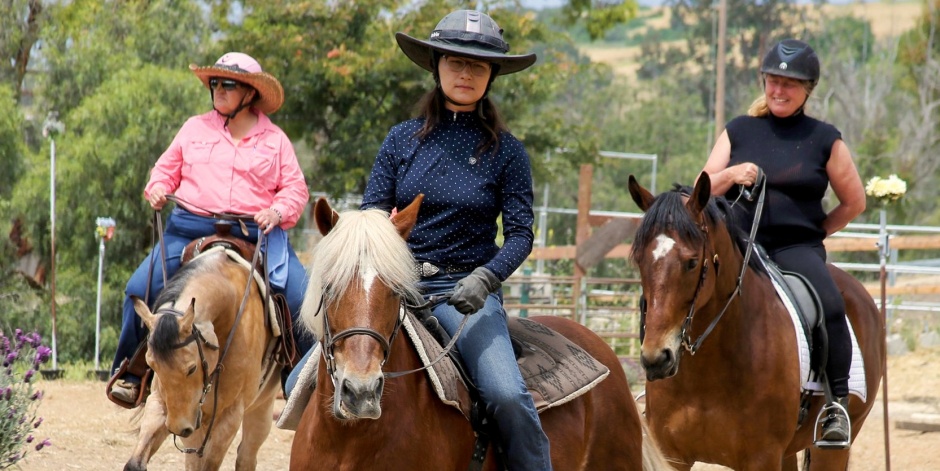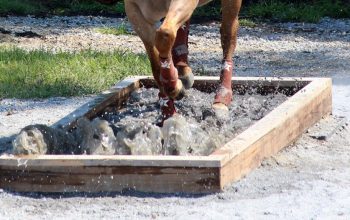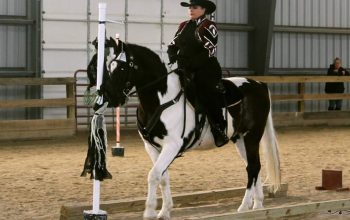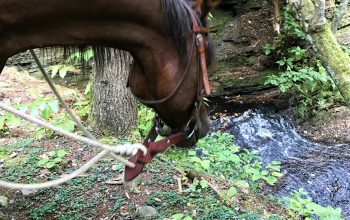By Julie Alonzo,
WE United President Elect
I’m writing this month’s article on my flight home from teaching a Working Equitation clinic followed by a one-day schooling show. My skin has that slight tingle that accompanies a bit too much sun and wind after a winter of being tucked away indoors, and my feet ache from all the standing I’ve done over the past two days, a bit different than my weekday routine comprised mainly of computer work. What I’m feeling more than anything else, however, is the deep sense of contentment that comes from seeing firsthand the improvements in the partnerships the sport fosters between horses and their riders.

The group I worked with this weekend reflects so many others I’ve had the privilege to teach: a mixture of accomplished riders and those just starting their journey with horses. At almost every clinic I teach, a number of people have found Working Equitation after having met competition goals in other sports. In this weekend’s group, we had people who had competed successfully in jumping, dressage, western trail, and hunter under saddle. One of this weekend’s participants owns and runs a busy equine facility, providing lessons to over 120 students each week in a mixture of group and individual instruction. Another holds a National Championship title in Western Trail. The event organizer grew up on a Thoroughbred breeding farm in Kentucky and still has close family connections among racing’s elite.
But, in the true spirit of inclusion that seems to thrive in Working Equitation, the group also included a rider who has only recently picked up the reins and stepped into the stirrups after a lifetime of interest in horses. She was joined by a woman with experience pleasure riding on the trails but no prior time in a show ring. And, over the course of two days, everyone advanced.
The dressage rider found that having the obstacles on which to focus helped her better prepare her horse for halts, a movement with which she had previously been struggling. As the weekend progressed, she and her warmblood consistently delivered smooth, square, and balanced halts. Even better, they were able to produce them in the dressage court just as solidly as when halting for the jug, bell corridor, and gate in Ease of Handling.
The western trail rider found that the Double Slalom and Drums, in particular, helped her horse carry itself more in balance, as the two of them began to dance together more harmoniously. The horse stopped dropping its shoulders in the turns, and the rider learned to focus more on guiding her horse through the movements in ways that encouraged that balance.
Two of the participants learned their first-ever dressage patterns over the weekend, successfully performing all the movements in the right place and at the right time… truly a victory!
Reflecting on the relationship between the obstacle work and the dressage test, one of the new riders shared her revelation, “This turn outside the pen, that’s basically that ‘bow-tie’ movement we did in the dressage test, and the bell corridor is asking us to do the same thing we did when we halted at ‘C’ and then demonstrated rein back. I can totally see how perfecting our ability to open and close the gate will translate to being able to maneuver my horse around tight places on a trail ride!”
I found myself smiling at her as I nodded agreement. “Yes, Working Equitation really does have real-world application, and the skills we look for in one trial really do come up again in the others.”

At this particular clinic, we focused on the obstacles to begin with on Saturday, with small groups working their way through ten or so obstacles over the course of two hours. We then devoted two hours in the evening to learning the introductory dressage test all together. I started off coaching each rider through the first two movements, then taught the next four movements and had the group ride the test from the start once more, one after another. Because of the way that the dressage movements tend to repeat a bit—what you do on one side ends up being ridden again on the other side of the court—I was able to teach the remaining seven movements in one chunk. Thus, on their third time in the dressage court, each rider rode all the movements in the Introductory Dressage test in the correct sequence. By the time the last clinic rider made her final salute, all participants had the test memorized.
The second day of the clinic was structured as a schooling show. Each of the participants rode their dressage test in the morning, and I was delighted to see that the pattern remained etched in their memories. Horses and riders moved seamlessly through the movements that just 14 hours before had seemed insurmountable to several of them. As a group, we set up the obstacles and did a course walk prior to lunch. To help reinforce the learning from the day before, I asked different clinic participants to demonstrate each obstacle as we walked, complete with a verbal explanation of the technical aspects the judge would be looking for and hints for improving the quality of their performance. If the person providing the explanation faltered, other members of the group chimed in, personally embracing one of the philosophies of the sport—that riders help and support one another in the journey.

After lunch, each participant first completed the obstacles as an Ease of Handling ride, while I filled out a scoresheet so they would have something to take with them to guide their future practice. After a short break to let their horse recover, they then rode the same course, but this time we timed it. I explained to the participants that normally they would not do the Speed trial if they were riding at the Introductory level, but that I wanted them to get a feel for how they could still maintain a quiet, soft ride with their horse yet shave precious seconds off their time by selecting course lines with the speed test in mind.
As each horse/rider pair waltzed through the Ease of Handling course and then picked up the pace slightly to boogie in Speed, all in attendance saw firsthand how much horses and riders alike came alive and seemed to enjoy adding a little “zip” to their obstacle performance, all the while maintaining quietness and relaxation in the obstacles themselves.
Lots of laughter, big smiles, and bright-eyed horses filled the arena as—once again—a pony turned in the fastest time of the day, underscoring the truism that extra agility and the ability to maneuver well in tight spaces often comes with smaller stature.
I truly do love teaching these introductory clinics because it is so gratifying to see people become more attuned to their horses and horses more willing to listen to and trust their riders. Equally gratifying, though, are the opportunities such events provide for people to support one another, to cheer each other on, and to willingly accept the challenge of becoming more aware of how their attitude, posture, focus, and ‘self-talk’ can either bolster or degrade their ability to achieve their goals.
Although many equine activities provide similar opportunities for such growth, in my fifty years with horses and horse people, I have yet to find anything else that so consistently fosters strong improvement in horsemanship while simultaneously helping people become kinder and more supportive of one another. No wonder Working Equitation is catching on so quickly across North America!
____________________________________________
To learn more about WE United visit their website: www.weunited.us





